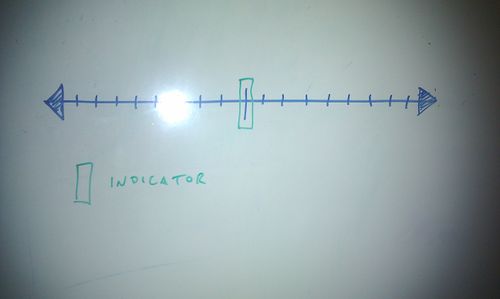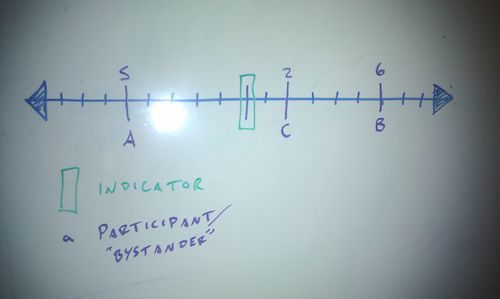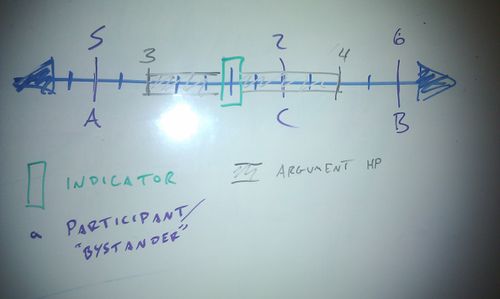Journey: Social
Let's start talking about social combat in Journey.
Contents
Overview
Social combat is a lot more fluid than physical combat, in that there are a lot of directions to take.
In essence, a social combat is defined as two or more opposing parties putting forth viewpoints and making arguments against each other or to bolster their own position. The goal may be to make a third party agree with one or the other, or it may be to change the other person's position to match your own.
As mentioned, social combat is a lot more fluid in that it must, by necessity, have higher points-of-contact than physical combat, in order to accurately model what is happening in-world. Just as individuals in a combat must maneuver to be near each other, and thus have a physical location, two social combatants must have a conversational location, which - unlike physical combat - is defined by those involved in the social combat. This location shifts as the conversation goes on, much as individuals on a tactical grid maneuver.
Terms
Mode
- The type of social conflict in question. Mediate is seeking to find a middle ground between two parties, such as in haggling. Debate is a situation in which two individuals are trying to convince each other to change their position. Appeal is an attempt to convince an individual to agree with you, who is not necessarily arguing back.
- Each mode behaves slightly differently in terms of goals and mechanics. However, they share the same fundamental framework.
Measure
- A basic social combat "weapon." Measures are the basic means by which an individual may perform all social combat-relevant actions.
Indicator
- This is the central line of the social combat, except in mediation, in which there are two indicators. Individuals on the same side of an indicator all agree with the argument's stance, generally set by whoever initiated the argument. At the end of a social conflict, all individuals involved modify their ethos according to which side of the indicator they are on, by means of gaining experience towards the relevant virtue.
Certainty Points (CP)
- What was once called "social hit points," these are a measure of your belief in your stance and your conviction to stand by it. Measures can be used to both increase this amount and reduce it, but you can never have more than your initial CPs in a given argument.
Argument Type
- Similar to damage types, argument types help define the sort of argument being presented, such as a logical argument or an emotional one. Your ethos helps define your resistance and vulnerability to different sorts of arguments, and the virtue set used in an argument helps or hinders different argument types. Using logic damage against a strongly Red individual will not be helpful, and the strength of Logic-type arguments will be reduced on the Red side of a Blue / Red virtue set.
Aplomb Points (AP)
- Aplomb is a measure of your ability to keep your cool and maintain a level head in an argument. You begin an argument with AP equal to the max of your Wisdom attribute. You can expend aplomb to make a particularly impassioned argument, increasing its effectiveness, while "underhanded" social tactics of your opponent - or a barrage of points - reduce your aplomb.
- You can regain aplomb by taking an action on your turn in the argument to compose yourself.
- If your aplomb drops to zero, you can no longer participate in the argument. If you were the only participant arguing for your side, the argument ends and you lose the argument. If your opponent is an NPC and loses the argument due to aplomb damage, you win the argument but your reputation with them drops, as you won through "unfair" means. Depending on the nature of the argument, this may make your opponent actively hostile towards you.
Mechanics
There are three types of argument: mediation, debate, and appeal. We'll cover debate first, as that is the way social combat has traditionally been examined and designed in the past. The other two variations are not that distant from debates, but are different enough that they need to be covered separately.
Debate
A debate always has at least two components: one indicator, and two principle participants. While more participants may exist, these two set the bounds of the argument - they are the foundations on which the argument lies, and if one's opinion is swayed, the argument is over.
Note that, in some debates, it may be possible that one individual is arguing against multiple individuals, with different ethoi and convictions. In this case, a different line needs to exist for each pairing: this is to track argument effectiveness against each opponent.
- Example: You are attempting to convince a bandit king to stop harassing a given road. Also in the room are his various minions, as well as his right-hand man. While the minions are largely irrelevant to the discussion - they'll do what their boss says - the right-hand man may not agree, and must be swayed separately. This argument will have two conflict lines, with you on one end of both, and the bandit king on one and his right-hand man on the other. Arguments you make affect the two differently, while arguments either makes affect your argument the same.
Mediators, in particular, have specials designed to assist them in winning over crowds of people. While non-mediators can attempt to do so, it is much easier for a mediator.
In addition, at this stage, the particular virtue set most pertinent to the argument needs to be determined, as per the ethos subsystem. There is no mechanical means to determine the virtue set - this requires a degree of arbitration on the LM's part, to ensure that the virtue set chosen most reflects the nature of the discussion.
- Example: You are attempting to convince the king to not attack his neighbor, who he believes has attacked his kingdom unprovoked. This argument seems to most closely correlate to the Caution / Impulse virtue set, though it could also be argued that this falls under Harmony / Animosity or Trust / Paranoia.
If an argument would seem to fall under multiple virtue sets, you can set up multiple social conflict lines, one for each virtue set. In such an instance, all individuals must be on the same side of the indicator for all social conflict lines. In such an instance, you make one argument at a time, which is then applied to both lines.
- Example: Continuing the king example, the argument winds up being a complex social conflict, with both a Caution / Impulse and Trust / Paranoia virtue set conflict line. To convince the king, you must get him on your side of the indicator on both lines.
Note that the virtue set used helps define the "terrain" of the conflict - some argument damage types are less effective in given virtue sets, while others are more effective. Thus, while you can make only a single argument, it may be more effective on one line or the other, thus requiring you to vary your arguments and appeal to all the relevant virtue sets in the conflict.
Once the requisite conflict lines have been constructed, the participants need to be placed on the line. An individual's Certainty Points (CPs) are based upon the virtue set used for the conflict, as well as the participant's Spirit (soul endurance).
- Formula: Max CP = max(0, Virtue Rank - Opposed Virtue Rank) + max(Spirit)
- Example: You are in a Responsibility / Freedom argument, and are arguing on the side of Responsibility. You have a Responsibility rank of 4, a Freedom rank of 1, and a Spirit of rank 3 (1d6). Thus your total CPs for this argument are 9 ([4 - 1] + max[1d6]). If your Responsibility rank were lower than your Freedom rank, you would count that as a 0 - while you can argue for a position you do not believe in, you will be much easier to sway to the opponent's viewpoint, given your bias.
From this, we can see that an individual who believes strongly in a given virtue will not be easily swayed, while an individual who has great experience in both, but has not made a strong choice, will still be relatively easily swayed.
If you are in a complex social conflict - that is, there are multiple virtue sets involved - your CPs vary on each conflict line dependent upon the virtue set. Effects that modify your CPs on one conflict line do not modify it on another (shoring up your resolve in a White / Red conflict has little effect on your conviction in your stance in the Green / Black aspect of the argument).
Note that mediators have access to talents and specials that allow them to improve their CPs, gaining an edge in social conflicts.
Once all relevant participants are placed on the conflict line, the conflict proper can begin. Unlike in physical combat, where speed and tenacity triumph, arguments tend - tend! - to be somewhat more civil, with one individual making a point, then the other. They tend to be reasonable exchanges of ideas and points, rather than an attempt to pummel the opponent with a verbal barrage (though that, too, is a viable tactic).
Action costs for social measures are based on Acumen, rather than Speed. This reflects the fact that more intelligent individuals are able to form cogent thoughts faster, and - indeed - can put forth complicated arguments in the span that normal folk can only form a few basic ideas.
Thus, much as in combat, each of the principle participants rolls for initiative, with the highest going in tick 0, and everyone else in tick (highest init - their init).
On each participants' turn in the initiative order, they can perform one of the following actions. Each has an associated measure, while mediators have access to specials which are more varied and allow for greater options or effectiveness.
- Reduce opponent's CP.
- Reduce opponent's AP.
- Reduce opponent's argument's HP.
- Increase own CP.
- Increase own AP.
- Improve own argument's HP.
- Move an indicator.
The following actions are interrupts, meaning that they can be used in response to an opponent taking an action.
- Prevent lowering of someone's CP.
- Prevent lowering of some argument's HP.
- Prevent movement of an indicator.
...the journey of a thousand miles...
|
Journey
|
...begins beneath your feet...
| |||||||||||||||||||||||||
|---|---|---|---|---|---|---|---|---|---|---|---|---|---|---|---|---|---|---|---|---|---|---|---|---|---|---|---|
| |||||||||||||||||||||||||||



